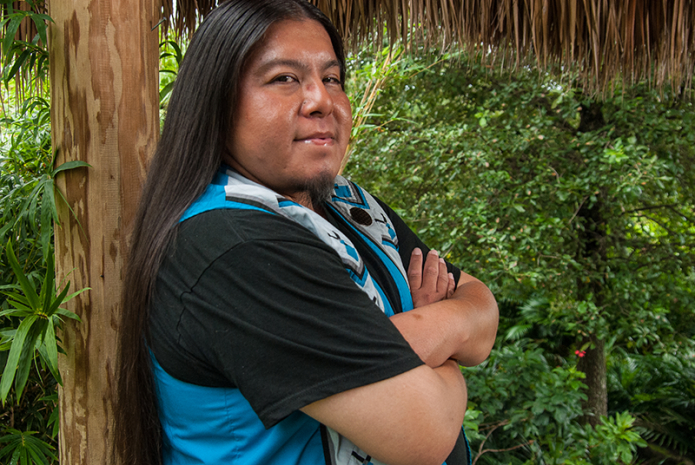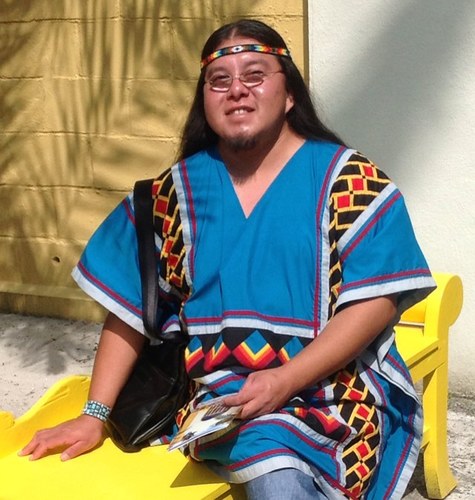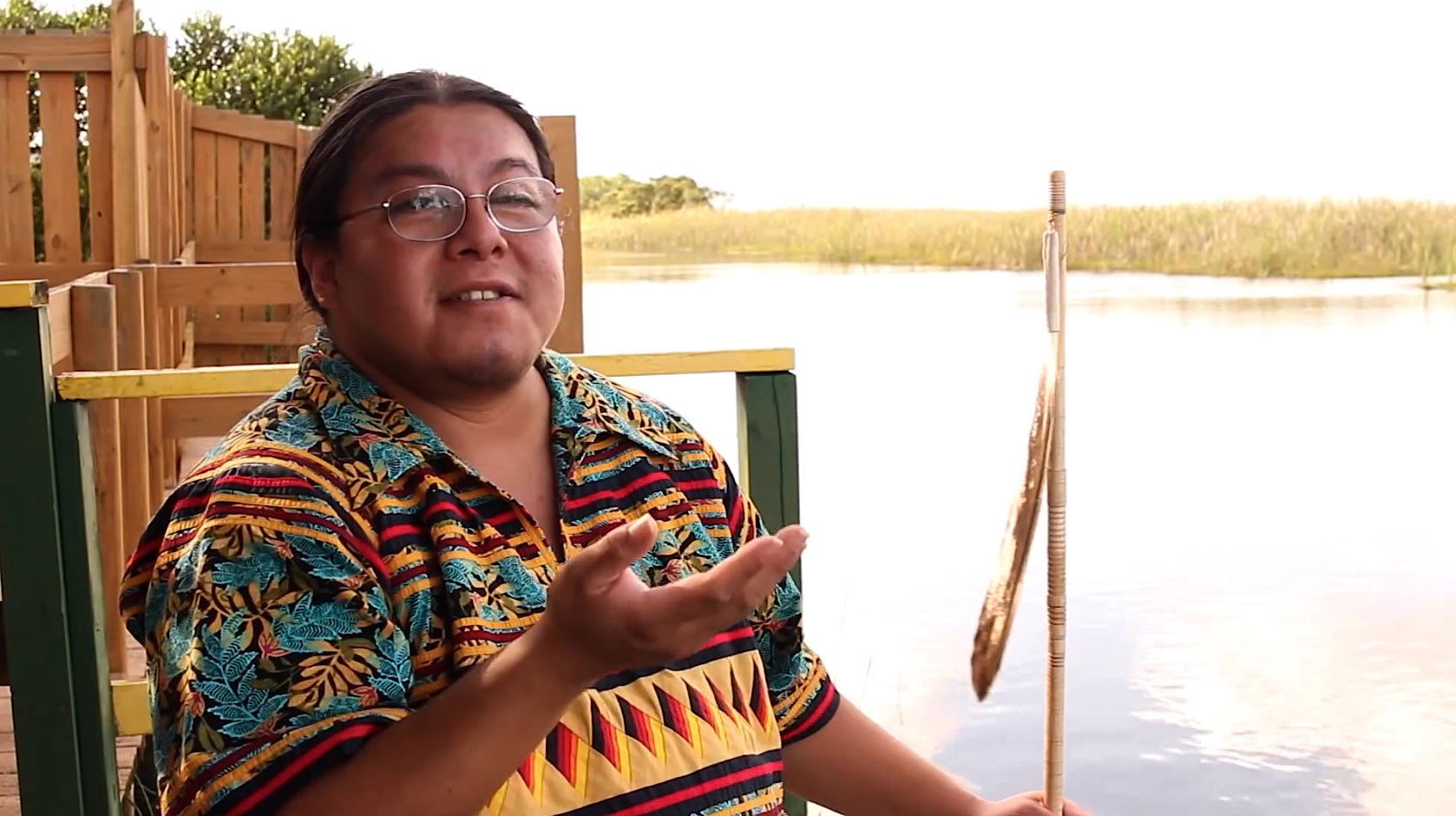Miccosukee Native
Houston Cypress Speaks
* As with all other articles on the Tomorrow’s Ancestors Speak video pages, this article is meant only as an accompaniment to the video message containing the speakers’ main ideas.
Soaring amidst a 60-mile wide (96.6 km) river of tall golden grasses hosting dances of light from waters below, we embark upon our journey into the unique Everglades region of southern Florida. Amongst the lower 48 states, the Everglades ecosystem remains the United States’ largest sub-tropical wilderness, providing homes to over 360 bird species, 300 fish species, 50 reptile species, and 40 mammal species – many now endangered or threatened with extinction. We have come to the Everglades to speak with Miccosukee Native, Houston Cypress about the environment and culture of his people in an area they call, “Kahayatle,” the shimmering waters.
Houston begins by telling us how the Everglades were not always the Miccosukee people’s home. The Miccosukee people had fled to the Kahayatle from both Southern Georgia and Northern Florida during the European invasion of the seventeenth and eighteenth centuries. In this large watershed of the Everglades, the Miccosukee found refuge and a place to keep their traditions alive. Today the Miccosukee people live both on and in the surrounding areas of their reservation, with a small fraction of the population carrying forth the native Mikasuki tongue.
Houston, whose mother was delivered by a medicine man along the Turner River, is one of those still carrying the Mikasuki language (as well as English and Spanish). Houston is an individual driven to engage greater community outreach in regards to the preservation and protection of both the environment and Miccosukee culture. Growing up within a traditional Miccosukee community he was reminded often about the circle of life. His grandparents told him many stories about the myriad relationships experienced amongst the plants and animals. They also described to Houston the vast varieties of birds that had lived in the territory in populations so great that they would block the sun as they flew over. Nowadays bird populations have declined significantly in the region with some species experiencing a 90 percent drop during the last fifty years. This avian predicament, however, is just one alarm bell calling attention to the decreasing health and stability of the ecosystem.
During the last 100 years over half of the Everglades have been lost to agricultural and residential development, with the remaining habitat under constant attack from polluted runoff, canals, levees, roads, water-control structures, invasive species, and climate change. Houston explained to us how these transportation and water-control structures prevent the natural flow of water from occurring, thereby causing instability in the water levels and leaving areas too dry or wet for too long. These threats of water quantity and quality effectively kill the plant islands that are home to many birds and animals, and prevent natural migration patterns from occurring. With the control and reduction of wildfires so essential to the lives of native plant species, the introduction of invasive (plant, insect, and animal) species, polluted runoff from industry, agriculture (primarily sugar cane and dairy), urban encroachment, and increasing demand for fresh water for growing cities, we encounter a situation where we are loosing the last remaining home of the Miccosukee people and the various plants and animals that live solely on this small piece of our ever-shrinking planet.
Yet peace arrives as we drink in the beauty of the wetlands. Houston continues on by telling us about how his family and community have been directly impacted by these changes. He describes how invasive plant species that have been spurred by industrial fertilizers in the water often choke out native species that are traditionally used in many practices and ceremonies – thereby bringing difficulty to keeping these rituals alive. These invasive plants are also inhibiting the Miccosukee’s access to their sacred places and the ways in which they grow their traditional vegetables. Additionally, other contaminates in the water have made it so his family and community can only eat fish and other animals from the area on a limited basis without the risk of poisoning.
Even amidst these challenges, Houston and his community maintain a strong relationship with the surrounding waters and firmly believe in the lessons interwoven amidst their prophecies. In regards to certain Miccosukee prophecies that tell of much destruction, Houston states that,
“Sometimes these prophecies can tell us about Earth changes and changes in the environment that we see today that might look very negative. But I’m reminded of things that my parents and uncles tell me, that yeah, some of these stories and prophecies can be a little jarring or even scary, but they’re not necessarily for that. They are supposed to spur action for us to do something about it. But we need a broader coalition to help us out.”
Listening to these prophecies, Houston experiences much desire to bring forth this necessary action. He provided us with a few of the solutions that he feels are capable of restoring the Everglades vitality. One of the most impactful is making both the agricultural and industrial polluters pay for the damage that they have brought forth through their misuse and abuse of the region. Reconnecting to nature, to the source of life, and to the elements is another healing path. For the Miccosukee, this route is inclusive of songs, plants, medicine, and colors used in a traditional harmonious way. Houston remarks on how this respect and integrity given to the indigenous communities is essential for long-term stability. An additional mission is continuing to bring energy to the many restoration projects already in motion and to the creative projects yet to come. The last solution that Houston provided was to engage the broader community in these matters. He remarked that it is important to engage not only the people of south Florida and the southeast portion of North America, but people all across the world. Houston feels that the global community is helping to use Everglades restoration and the technologies and processes that are coming out of it as a template for their own local problems. Houston firmly states, “Everglades restoration has something to teach the world.”
Learn more about the Everglades Restoration Project that Houston is involved with by visiting http://www.lovetheeverglades.org/.
You can also visit the project’s Facebook page at https://www.facebook.com/LoveTheEverglades/



